Related Research Articles

Huelva is a province of southern Spain, in the western part of the autonomous community of Andalusia. It is bordered by Portugal, the provinces of Badajoz, Seville, and Cádiz, and the Atlantic Ocean. Its capital is Huelva.

Huelva is a municipality of Spain and the capital of the province of Huelva, in the autonomous community of Andalusia. Located in the southwest of the Iberian Peninsula, it sits between the estuaries of the Odiel and Tinto rivers on the Atlantic coast of the Gulf of Cádiz. According to the 2010 census, the city had a population of 149,410.
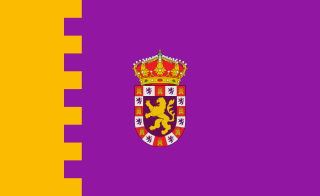
Almonaster la Real is a town and municipality located in the province of Huelva, Spain. According to the 2005 census, the city had a population of 1,805 inhabitants.

Corta Atalaya is the largest open-pit mine in Europe and was at one time the largest in the world. It is located within the city limits of Minas de Riotinto in the province of Huelva, autonomous community of Andalusia, Spain. It is roughly elliptical in shape, 1,200 metres (3,900 ft) long, 900 metres (3,000 ft) wide, and 350 metres (1,150 ft) deep. It was one of the most ambitious projects of the Rio Tinto Group. At its peak it employed 2,000 workers mining copper; it was actively mined until 1992. Since at least 1994 it has been flooded up to the 16th ring.
La Zarza mine is an abandoned mine near the town of La Zarza-Perrunal, Huelva, Andalusia, Spain. The deposit is part of the Spanish part of the Iberian Pyrite Belt. The orebody is 2,900 meters long and up to 100 meters thick. Like most of the volcanogenic massive sulfide ore deposit in the IPB it contains significant amounts of copper, zinc, lead, silver and gold.

El Andévalo or El Campo de Andévalo is a comarca in Huelva Province, Andalusia, southern Spain. It is located between the Sierra de Huelva, Costa Occidental, Cuenca Minera, Huelva and Condado de Huelva comarcas and the border of Portugal.

Tharsis is a village that is part of the Alosno municipality in the province of Huelva, Spain. According to the 2013 census, the village has a population of 1,840 inhabitants.
The Aroa mines were copper mines in the state of Yaracuy, Venezuela. Mining started in 1632, and at the end of the colonial period the mines were owned by the Bolívar family. Simón Bolívar leased the mines to an English company, and after his death his sisters sold the mines. They continued to be operated by English companies, using Cornish and local miners, until 1936. Today the mines are closed and partially flooded. Their remains are preserved by the Parque Bolivariano Minas de Aroa and may be visited by the public.
La Zarza-Perrunal, known until 1991 as Silos de Calañas and Minas de Perrunal, is a municipality located in the Province of Huelva, in the autonomous community of Andalusia, Spain, which includes the localities of La Zarza and Perrunal, since their separation in 2018. Before then, it belonged to the municipality of Calañas. The municipality is part of the Andévalo comarca although it is located at the foot of the Sierra de Aracena.

The Rio Tinto Company Limited (RTC) was one of the founding companies of the Rio Tinto Group conglomerate, which was responsible of the exploitation of the Riotinto-Nerva mining basin in Minas de Riotinto between 1873 and 1954.
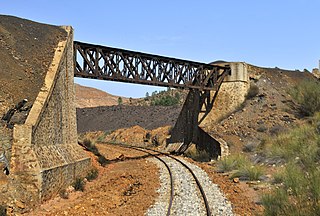
The Riotinto Railway was a Spanish narrow-gauge railway line, predominantly used for mining and industry, that operated between 1875 and 1984. During this time it became one of the main railways in the province of Huelva, gaining a large fleet of rolling stock.

The Tourist Mining Train is a Spanish tourist train that travels along the historic Riotinto Railway, in the province of Huelva, autonomous community of Andalusia. The first railway services were started in 1994 by the Río Tinto Foundation, using historical rolling stock. The tourist train is part of the Rio Tinto Mining Park, constituting one of its most attractive elements.
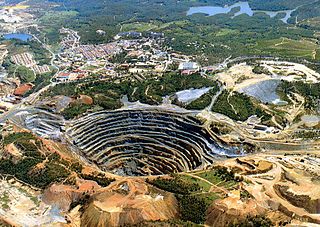
The Riotinto-Nerva mining basin is a Spanish mining area located in the northeast of the province of Huelva (Andalusia), which has its main population centers in the municipalities of El Campillo, Minas de Riotinto and Nerva, in the region of the Cuenca Minera. It is also part of the Iberian Pyrite Belt.
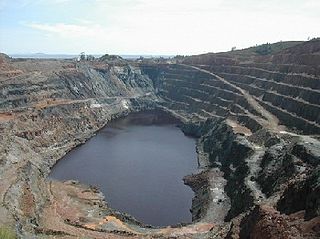
The Tharsis-La Zarza mining basin, colloquially known as the Tharsis mines, is a Spanish mining area located in the province of Huelva. Its main centers are in the municipalities of Alosno, Calañas, Cerro de Andévalo and La Zarza-Perrunal. The basin is part of the Iberian Pyrite Belt.
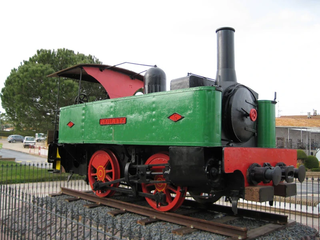
The Tharsis railway line, also known as the Tharsis-Río Odiel railway, was a Spanish narrow-gauge railway of mining industrial nature that operated between 1871 and 2000. It served as one of the most important railroads in the province of Huelva.
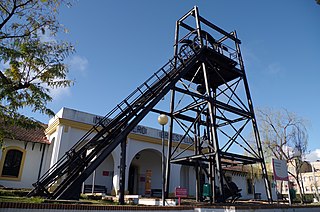
Riotinto Mining Museum "Ernest Lluch" is a museum located in the Spanish municipality of Minas de Riotinto, in the province of Huelva, which is dedicated to the mining activity in the area and its history. The facilities were inaugurated in 1992 and are managed by the Rio Tinto Foundation. It has an important collection ranging from archaeological pieces to mining machinery and railroad locomotives.
Tharsis is a Volcanic Plateau on Mars, sometimes called the Tharsis Bulge; the name is a greco-roman transliteration of the biblical Tarshish.
The Compañía Española de Minas de Tharsis was a Spanish company belonging to the mining sector, whose activity was developed mainly in the Tharsis-La Zarza mining basin. It was born as heir to the former British company that had operated the Tharsis mines since the mid-19th century. The company was active between 1978 and 1995, ceasing operations due to the crisis that the sector was going through at that time.

The Gibraleón-Ayamonte line, also known as the Huelva-Ayamonte line, was a 49-kilometer-long Iberian gauge Spanish railway line that came to operate in the province of Huelva. The line was in operation between 1936 and 1987, covering the western coast of Huelva.
Nueva Tharsis is a Spanish mining company based in the town of Tharsis, Huelva, Spain. It is the heir of several of the companies that have been exploiting the deposits of the Tharsis-La Zarza mining basin since the second half of the 19th century.
References
- ↑ Costa, María Teresa. (1983). La financiación exterior del capitalismo español en el siglo XIX. Ed. de la Universidad de Barcelona. ISBN 84-7528-051-X. OCLC 492184963.
- ↑ McCrone, David. The new sociology of Scotland. SAGE Publications. ISBN 978-1-5297-1469-2. OCLC 1245350085.